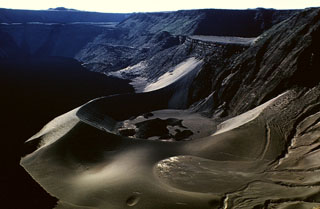Report on Cerro Azul (Ecuador) — 28 May-3 June 2008
Smithsonian Institution / US Geological Survey
Weekly Volcanic Activity Report, 28 May-3 June 2008
Managing Editor: Sally Sennert.
Please cite this report as:
Global Volcanism Program, 2008. Report on Cerro Azul (Ecuador) (Sennert, S, ed.). Weekly Volcanic Activity Report, 28 May-3 June 2008. Smithsonian Institution and US Geological Survey.
Cerro Azul
Ecuador
0.92°S, 91.408°W; summit elev. 1640 m
All times are local (unless otherwise noted)
Based on information from the Galápagos National Park, observations of satellite imagery, and seismicity, the IG reported that Cerro Azul started to erupt on 29 May from several points along a radial fissure on the SE flank in the Cinco Cerros area. A thermal anomaly was present on satellite imagery at about the same time incandescence was seen through cloudiness in the direction of the volcano from ground observations. On 30 May, a plume, possibly with low ash content, was seen on satellite imagery drifting NW. An overflight and further observations revealed that lava flows traveled about 10 km down the SE flank over older flows from eruptions in 1978 and 1998. According to a news article, the lava flows were active during 29 May-1 June and burned vegetation on the flanks of the volcano.
Geological Summary. Located at the SW tip of the J-shaped Isabela Island, Cerro Azul contains a steep-walled 4 x 5 km nested summit caldera complex that is one of the smallest diameter, but at 650 m one of the deepest in the Galápagos Islands. The shield volcano is the second highest of the archipelago. A conspicuous bench occupies the SW and west sides of the caldera, which formed during several episodes of collapse. Youthful lava flows cover much of the caldera floor, which has also contained ephemeral lakes. A prominent tuff cone located at the ENE side of the caldera is evidence of episodic hydrovolcanism. Numerous spatter cones dot the western flanks. Fresh-looking lava flows, many erupted from circumferential fissures, descend the NE and NW flanks. Historical eruptions date back only to 1932, but Cerro Azul has been one of the most active Galápagos volcanoes since that time. Solfataric activity continues within the caldera.
Sources: Instituto Geofísico-Escuela Politécnica Nacional (IG-EPN), Agence France-Presse (AFP)

